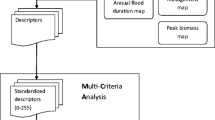Abstract
A process has been developed to select watersheds that are representative of terrestrial ecoregions and that are relatively undisturbed by human activity. Using an existing land classification system at two hierarchical levels of resolution, representative subsets (ecodistricts) of large-scale ecoregions were selected, on the basis of their physiographic, biological, and climatological attributes, to represent the ecoregions. This was achieved using a frequency distribution analysis of existing attribute data and choosing the ecodistrict most closely resembling the most common set of conditions for that ecoregion. Within each ecodistrict, river basins were selected through a best-judgement evaluation of land use, coupled with an assessment of the size and location of each river basin, in order to meet the condition of minimal human impact. Preliminary assessment of water quality data collected from six watersheds selected in this way suggests that the process is effective in targeting regional scale river basins exhibiting the desired characteristics.
Similar content being viewed by others
Literature Cited
Environment Canada. 1989. Ecoclimatic regions of Canada, first approximation. Sustainable Development Branch, Environment Canada. Ecological Land Classification Series No. 23. Ottawa, Ontario. 118 pp.
Environment Canada. 1990. The application of an interdisciplinary approach to the selection of potential water quality sampling sites, Magnetewan River Basin. Internal Report Series, Water Quality Branch, Environment Canada. Burlington, Ontario. 68 pp.
Environment Canada. 1991. The application of an interdisciplinary approach to the selection of potential water quality sampling sites, Pukaskwa River Basin. Internal Report Series, Water Quality Branch, Environment Canada. Burlington, Ontario. 72 pp.
Gallant, A. L., T. R. Whittier, D. P. Larson, J. M. Omernik, and R. M. Hughes. 1988. Regionalization as a tool for managing environmental resources. EPA/600/3-89/060. US Environmental Protection Agency, Corvallis, Oregon.
Heiskary, S. A., and W. W. Walker. 1987. Analysis of regional patterns in lake water quality: Using ecoregions for lake management in Minnesota.Lake and Reservoir Management 3:337–344.
Hughes, R. M., and D. P. Larsen. 1988. Ecoregions: An approach to surface water protection.Journal of Water Pollution Control Federation 60:486–493.
Hughes, R. M., D. P. Larsen, and J. M. Omernik. 1986. Regional reference sites: A method for assessing stream potentials.Environmental Management 10:629–635.
Hughes, R. M., E. Rextad, and C. E. Bond. 1987. The relationship of aquatic ecoregions, river basins and physiographic provinces to the ichthyogeographic regions of Oregon.Copeia 2:423–432.
Larsen, R. P., D. R. Dudkey, and R. M. Hughes. 1988. A regional approach to assess attainable water quality: An Ohio case study.Journal of Soil and Water Conservation 43:171–176.
Lyons, J. 1989. Correspondence between the distribution of fish assemblages in Wisconsin streams and Omernik’s ecoregions.American Midland Naturalist 122:163–182.
Omernik, J. M., M. A. Shirazi, and R. M. Hughes. 1982. A synoptic approach for regionalizing aquatic ecosystems. Pages 199–218,in T. B. Brann, L. O. House IV, and H. G. Lund (eds.), In-place resource inventories: Principles and practices. Society of American Foresters, Bethesda, Maryland.
Ongley, E. D. 1986. Considerations for network design for water quantity and quality surveys in Canada.Water Pollution Research Journal of Canada 21(1):33–49.
Ongley, E. D., D. A. Birkholz, J. H. Carey, and M. R. Samiloff. 1988. Is water a relevant sampling medium for toxic chemicals? An alternative environmental sensing strategy.Journal of Environmental Quality 17(3):391–401.
Rohm, C. M., J. W. Giese, and C. C. Bennett. 1987. Evaluation of an aquatic ecoregion classification of streams in Arkansas.Journal of Freshwater Ecology 4(1):127–140.
Rubec, C. D. A., and E. B. Wicken. 1983. Ecological land survey: A Canadian approach to landscape ecology.Ekologia (CSSR) 2(3):263–271.
Tsoi, M., J. D. Fischer, and N. D. Warry. 1991. A methodology for selecting water quality sampling sites minimally impacted by human activity in the Ganaraska River Basin of southern Ontario. Internal Report, Inland Waters Directorate, Ontario Region, Environment Canada. 39 pp.
Whittier, T. R., R. M. Hughes, and D. P. Larsen. 1988. Correspondence between ecoregions and spatial patterns in stream ecosystems in Oregon.Canadian Journal of Fisheries and Aquatic Science 45:1264–1278.
Wickware, G. M. and C. D. A. Rubec. 1989. Ecoregions of Ontario. Ecological Land Classification Series, No. 26. Sustainable Development Branch, Environment Canada, Ottawa, Ontario, 34 pp. and map.
Author information
Authors and Affiliations
Rights and permissions
About this article
Cite this article
Warry, N.D., Hanau, M. The use of terrestrial ecoregions as a regional-scale screen for selecting representative reference sites for water quality monitoring. Environmental Management 17, 267–276 (1993). https://doi.org/10.1007/BF02394696
Issue Date:
DOI: https://doi.org/10.1007/BF02394696




